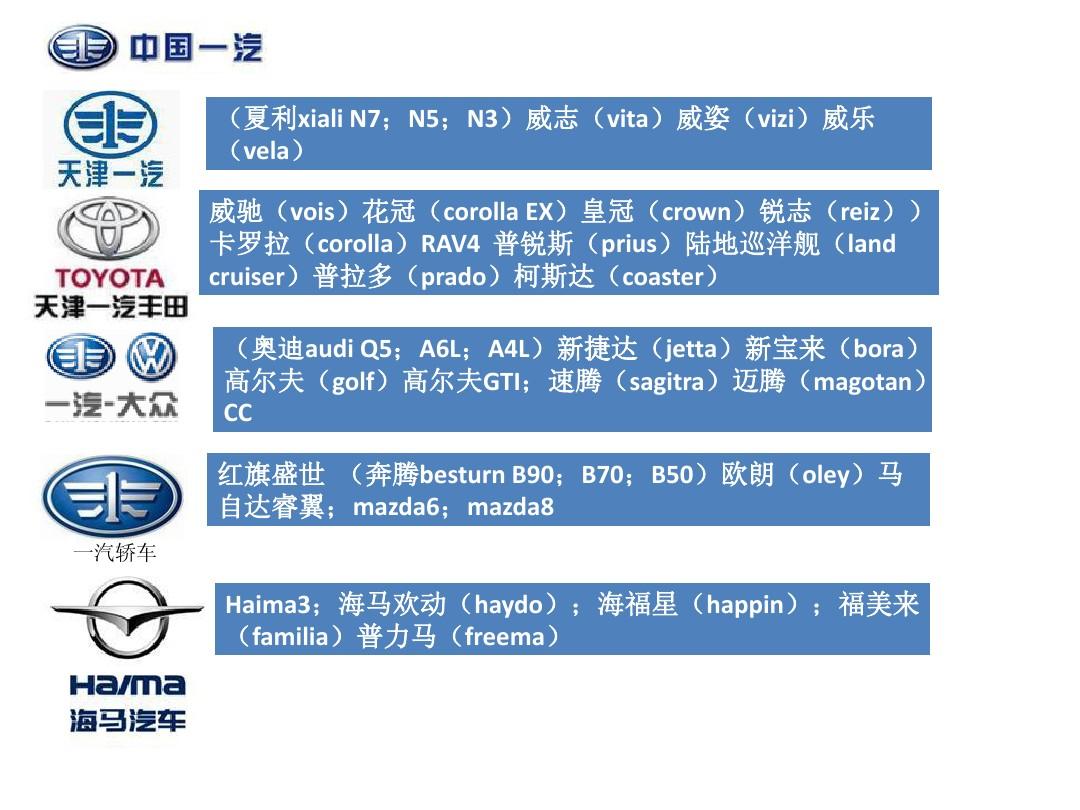国家汽车品牌讲解英文
摘要:本文介绍了国家汽车品牌的英文讲解。随着汽车产业的快速发展,国家汽车品牌在国内外市场上扮演着越来越重要的角色。本文概述了国家汽车品牌的起源、发展历程、品牌理念、产品线、技术创新以及在全球市场上的表现。这些品牌不仅在国内外市场上拥有广泛的消费者群体,而且通过持续的技术创新和产品升级,不断提高品牌竞争力和市场占有率。国家汽车品牌将继续发挥重要作用,推动中国汽车产业的持续发展。
在当今全球化的时代,汽车行业的发展日新月异,各国汽车品牌也在竞相发展,我将为大家讲解一下中国的国家汽车品牌及其在全球市场的影响力,中国汽车工业经过多年的发展,已经取得了长足的进步,形成了一批具有国内外影响力的汽车品牌,下面我们就来一起了解一下这些品牌的发展历程、产品特点以及在国际市场的表现。
品牌概述
中国汽车品牌众多,各具特色,像比亚迪、吉利、长城、奇瑞等品牌在近几年中逐渐崭露头角,这些品牌不仅在技术、品质上有了显著提升,还在国际市场上取得了一定的地位,我们将详细介绍这些品牌的发展历程和主要特点。

主要品牌讲解
1、比亚迪(BYD)
比亚迪是中国新能源汽车领域的领军企业,该公司成立于1995年,最初以电池制造为主业,后来逐渐扩展到汽车领域,比亚迪的电动汽车技术和电池技术是其核心竞争力,其新能源汽车在全球市场上销量持续增长,比亚迪的代表性车型包括秦、唐、宋等新能源汽车系列。
2、吉利汽车(Geely)
吉利汽车是中国汽车市场上的一匹黑马,该品牌成立于1997年,以其高品质和创新能力著称,吉利汽车在设计、技术和品质方面不断追求进步,推出了多款受到国内外消费者喜爱的车型,吉利汽车在国际市场上也取得了一定的成绩,尤其是在东南亚和南美市场,其代表性车型包括帝豪、博越等。
3、长城汽车(Great Wall Motors)
长城汽车是中国SUV市场的领军企业之一,该品牌成立于1984年,专注于SUV产品的研发和生产,长城汽车的产品特点是个性化、时尚化,其SUV车型在国内外市场上广受欢迎,长城汽车还积极拓展国际市场,尤其是在东南亚和非洲市场,其代表性车型包括哈弗H6、WEY等。
4、奇瑞汽车(Chery)
奇瑞汽车是中国汽车产业的佼佼者之一,该品牌成立于1997年,以其技术创新和国际化战略著称,奇瑞汽车在国际市场上具有较高的知名度,产品出口到全球多个国家和地区,奇瑞汽车的产品特点是性价比高,适合不同消费者的需求,其代表性车型包括QQ、艾瑞泽等。
国际市场表现
中国汽车品牌在国际市场上的表现日益突出,以新能源汽车为例,中国新能源汽车市场已经成为全球最大的市场,许多中国新能源汽车品牌在技术上取得了显著进步,与国际知名品牌展开竞争,中国汽车品牌还在国际汽车赛事中取得了优异成绩,提升了品牌的知名度和影响力。
案例分析
以吉利汽车为例,该品牌在国际化战略中取得了显著成果,吉利汽车通过收购沃尔沃、路特斯等品牌,提高了自身的技术水平和品牌影响力,吉利汽车还积极开拓国际市场,尤其是在东南亚和南美市场,取得了较好的销售业绩,这些案例表明,中国汽车品牌在国际市场上具有较大的发展潜力。
中国汽车品牌在发展过程中取得了显著成就,形成了具有国内外影响力的汽车品牌,这些品牌在技术创新、品质提升等方面取得了长足进步,并在国际市场上取得了一定的地位,中国汽车品牌将继续发挥自身优势,积极拓展国际市场,为全球汽车产业的发展做出更大贡献,以下是一个简单的表格来总结上述内容:
| 品牌名称 | 成立时间 | 主要产品特点 | 国际市场表现 | 代表性车型 |
| 比亚迪(BYD) | 1995年 | 电动汽车技术和电池技术 | 全球销量持续增长 | 秦、唐、宋等新能源汽车系列 |
| 吉利汽车(Geely) | 1997年 | 高品质和创新能力 | 东南亚和南美市场表现出色 | 帝豪、博越等 |
| 长城汽车(Great Wall Motors) | 1984年 | 个性化和时尚化的SUV产品 | 在东南亚和非洲市场表现突出 | 哈弗H6、WEY等 |
| 奇瑞汽车(Chery) | 1997年 | 技术创新和性价比高 | 产品出口到全球多个国家和地区 | QQ、艾瑞泽等 |
扩展阅读:
Introduction:
The automobile industry has been a cornerstone of modern civilization, with countries around the globe vying for dominance in this sector. From Japan's Toyota to Germany's Mercedes-Benz, each country has contributed significantly to shaping the global automotive landscape. In this article, we will delve into the history, evolution, and current state of several prominent national automobile brands from different countries. This exploration will highlight the key factors that have propelled these brands to their respective heights of success, including technological advancements, strategic partnerships, and a dedication to sustainability and quality manufacturing.
Japanese Automotive Industry:

In Japan, the automobile industry has long been synonymous with excellence and innovation. The Toyota Motor Corporation (TMC) stands as a prime example of how Japan has transformed from a nation known for its low-volume light trucks to a global leader in high-performance vehicles. TMC’s focus on quality engineering, customer-centric designs, and continuous improvement through Toyota's production philosophy—Kaizen—has positioned it at the forefront of the industry.
Toyota's commitment to safety features such as antilock brakes, traction control, and electronic stability control has earned it a reputation as the most trusted brand in its field. Additionally, the company's emphasis on fuel efficiency has helped it become one of the largest sellers of hybrid and electric vehicles globally. Furthermore, TMC's investment in research and development has led to groundbreaking technologies like Automatic Driving Systems, which are set to revolutionize the way cars operate in the future.
Germanic Automotive Prowess:
Germany, home to many iconic automobile brands, has long been a symbol of engineering excellence. Among them, Mercedes-Benz is perhaps the most renowned. The German brand’s legacy stretches back to the early 1900s when Karl Benz founded the company with his visionary design for a practical, comfortable vehicle. Today, Mercedes-Benz remains committed to producing luxury and performance vehicles while also embracing sustainable practices.
Mercedes-Benz is not just about the brand; it’s about the craftsmanship that goes into every car. The brand emphasizes attention to detail, meticulously designed interiors, and cutting-edge technology. Its engines are known for their reliability and efficiency, and the brand’s commitment to quality and innovation has kept it relevant in a rapidly changing market.
Indian Automotive Revolution:
Indian automobile industry has experienced a remarkable growth over the past few decades, transforming itself from a domestic market into a significant exporter. The rise of Indian automakers like Tata Motors and Mahindra & Mahindra is a testament to the country’s ability to adapt to international standards while maintaining local traditions and values.
Tata Motors, for instance, has carved a niche for itself by blending tradition with modernity to create a unique blend of luxury and affordability. The company’s focus on developing hybrid and electric vehicles aligns with the global trend towards green mobility. Mahindra & Mahindra is another powerhouse, leveraging its extensive network of dealerships and service centers to provide customers with a seamless experience across the product lifecycle.
Asia-Pacific Car Manufacturers:
In addition to the traditional giants, Asia-Pacific nations are also playing an increasingly significant role in the automotive industry. Countries like China, South Korea, and Australia are rapidly gaining momentum due to their strong manufacturing capabilities, innovative designs, and competitive pricing.
China’s automotive industry is the world’s largest, with a massive market share and a growing presence in the global supply chain. The Chinese brands, such as SAIC Motor and BYD, are known for producing affordable yet high-quality vehicles, catering to a wide consumer base. Meanwhile, South Korean manufacturers like Hyundai and Kia are known for their advanced technology and sleek designs.
Australia, too, is making a mark on the global automotive stage with its range of premium brands. Holdings Group Pty Ltd is one such company that has successfully blended Australian heritage with global standards, creating vehicles that offer unparalleled driving experiences while being environmentally conscious.
Conclusion:
The national automobile brands discussed above represent the diverse facets of the global automotive landscape. Each country's journey to becoming a leading automaker is marked by a combination of technological advancement, strategic partnerships, and adherence to sustainable practices. As the world continues to evolve, these brands will undoubtedly continue to play a crucial role in shaping the future of transportation. By embracing innovation, staying ahead of the curve, and maintaining their roots in their respective cultures, they are setting the bar even higher for the industry's next generation of leaders.
与本文知识相关的文章:



